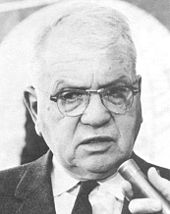Harold C. Urey
Harold Clayton Urey (born April 29, 1893 in Walkerton , Indiana , † January 5, 1981 in La Jolla , California) was an American chemist and Nobel Prize winner .
life and work
Urey studied zoology at the University of Montana (Bachelor 1917) and received his PhD in chemistry in 1923 from the University of California, Berkeley . 1918/19 he was with the Barrett Chemical Company, 1919 to 1921 instructor for chemistry at the University of Montana and 1923/24 at the University of Copenhagen. From 1924 to 1929 he was an associate in chemistry at Johns Hopkins University . From 1929 he was an associate professor at Columbia University in New York , became a professor there in 1934, was from 1945 to 1958 at the University of Chicago and then at the University of California in San Diego . From 1970 he was Professor Emeritus there.
In 1934 he received the Nobel Prize in Chemistry “for his discovery of heavy hydrogen ”, deuterium , from 1931. This was done in collaboration with the physicist Ferdinand Brickwedde and George Murphy.
Urey's main areas of work included the separation of isotopes as well as the atomic spectra and the spectra and structures of molecules. He is the inventor of Δ18O . This isotope study enables temperature reconstructions of fossils that are millions of years old. The procedure is still used today in climatology as a proxy .
During the Second World War , he worked with his team on various research projects within the Manhattan Project and in this way contributed to the development of the first atomic bomb . The most important of these was the development of the gas diffusion process to separate 235 U and 238 U.
Urey's interest was above all in the early stages of the planets and the primordial atmosphere. He also worked in the field of the origin of life. He summarized his findings in the book The Planets: Their Origin and Development , published in 1952 .
The experiment known as the Miller experiment is sometimes also called the Miller-Urey experiment (see Chemical Evolution ).
In addition to the Nobel Prize, he was awarded the gold medal of the Royal Astronomical Society in 1966 . In 1985 a lunar crater and in 2000 the asteroid (4716) Urey were named after him. The American Astronomical Society annually awards the Harold C. Urey Prize for Planetology , and the European Association of Geochemistry presents the Urey Award for Geochemistry annually .
In 1928 he became a Fellow of the American Physical Society . Since 1935 he was a member of the National Academy of Sciences and the American Philosophical Society . In 1938 he was elected to the American Academy of Arts and Sciences . In 1947 he was elected a Foreign Member of the Royal Society . He received the Davy Medal in 1940, the J. Lawrence Smith Medal in 1962 and the National Medal of Science in 1964 . In 2000 the asteroid (4716) Urey was named after him. In 1975 he received the VM Goldschmidt Award . The lunar crater Urey has been named after him since 1985.
literature
- Harold Clayton Urey: The planets - their origin and development. Yale Univ. Press, New Haven, 1952
- Harmon Craig, et al .: Isotopic and Cosmic Chemistry. North Holland, Amsterdam 1964
Web links
- Literature by and about Harold C. Urey in the catalog of the German National Library
- Information from the Nobel Foundation on the award ceremony for Harold C. Urey in 1934
- Entry for Urey, Harold Clayton (1893-1981) in the Archives of the Royal Society , London
- The Register of Harold Clayton Urey Papers 1929-1981 orpheus @ The UC San Diego Libraries
- Biography at the APS
swell
- ↑ Harold C. Urey: The thermodynamic properties of isotopic substances . In: Journal of the Chemical Society (Resumed) . 1947, p. 562. ISSN 0368-1769 . doi : 10.1039 / JR9470000562 .
- ↑ Michael Marshall: The secret of how life on earth began , on: BBC - Earth, October 31, 2016
- ↑ 4716 Urey (1989 UL5) JPL Small-Body Database Browser, accessed April 30, 2010.
- ^ Member History: Harold C. Urey. American Philosophical Society, accessed November 14, 2018 .
- ^ Members of the American Academy. Listed by election year, 1900-1949 ( PDF ). Retrieved September 27, 2015
| personal data | |
|---|---|
| SURNAME | Urey, Harold C. |
| ALTERNATIVE NAMES | Urey, Harold Clayton |
| BRIEF DESCRIPTION | American chemist, Nobel Prize in Chemistry 1934 |
| DATE OF BIRTH | April 29, 1893 |
| PLACE OF BIRTH | Walkerton , Indiana |
| DATE OF DEATH | 5th January 1981 |
| Place of death | La Jolla |
